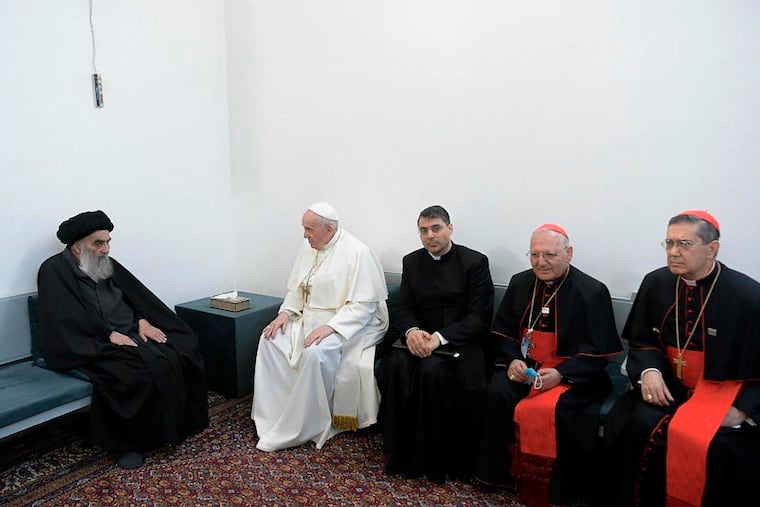What you didn’t know about the meeting between the Pope and the Ayatollah | Trudy Rubin
Both Pope Francis and Ayatollah Sistani are making a last stand for social justice and for pluralist societies.

The most stunning global event last week was the historic meeting of Pope Francis with Shiite Ayatollah Ali al-Sistani in a small, bare room in the holy city of Najaf, Iraq.
I say that not just because of the pope’s astonishing bravery in attempting to protect the remnants of Iraq’s ancient Christian sects, whose numbers have dwindled from around 1.5 million to 250,000, under attacks from ISIS and other violent Islamist extremists since the 2003 U.S. invasion. At age 84, in the time of COVID-19, the pope’s journey to Iraq was not for the fainthearted.
Nor do I say it only because the reclusive, ailing 94-year-old Sistani, perhaps the most revered Shiite cleric in the world, stood to greet the pope and joined him in condemning extremism.
No, this trip symbolized something much more significant, at a time when the world is convulsed by xenophobic nationalism, ugly strains of populism, and deep cracks within democratic political systems. It was a desperate last plea by global religious moderates for justice and peace.
» READ MORE: An Iraqi Christian oasis away from ISIS | Trudy Rubin
Both these religious leaders have promoted the rights of oppressed religious and ethnic groups and social justice for poor people, along with democratic political rule. But they have been challenged by hard-liners within their own religion and sects and by populist, authoritarian politicians. Their joint appearance was a poignant plea — perhaps a last stand — for values that are under increasing global threat.
I have walked the narrow alley in Najaf off which Sistani lives. (He almost never receives visitors, but takes questions via his son.) There is no question that he, like the pope, chooses to live humbly, avoiding any trappings of religious power. And don’t be fooled by the widely distributed photo of the two men in which the black-clad cleric looked wraithlike – he still wields immense religious power.
While Shiites are only around 15% of all Muslims, the vast majority of whom are Sunnis (they differ over the proper succession to the prophet Muhammad), Iran and Iraq are predominantly Shiite.
And Sistani is the preeminent Shiite ayatollah, leader of a school of religious thought that opposes direct involvement of clerics in political leadership. Thus he opposes the rule by clerics practiced in Shiite Iran since the 1979 Islamic revolution – and has endorsed constitutional elections in Iraq.
I was in Iraq in 2005 when the first national elections were held. Posters all over Baghdad featured photos of the ayatollah telling Iraqis, especially his Shiite followers, to go to the polls. He has also supported youthful Iraqi demonstrators protesting corruption in government, including within Shiite political parties.
And Sistani, along with his religious establishment in Najaf, urged his followers to fight ISIS and protect Christians from persecution. He has also urged Shiite militiamen who fought ISIS to join the government or return home.
So when Sistani reaffirmed the right of Iraq’s “Christian citizens to live like all other Iraqis in safety and with their full constitutional rights,” this was not pablum. Similarly, when Francis urged Iraqis – after years of sectarian war – to show that “fraternity is more durable than fratricide,” his plea was backed up by personal risk.
Francis has campaigned all over the world for the poor and the marginalized, and even once washed the feet of Muslim asylum-seekers. He has criticized the growth of nationalist populism in Europe and warned that it could lead to a new Hitler. And he called former President Donald Trump “not Christian” for his anti-migrant rhetoric. The one time he met Trump he gave him a treatise on climate change.
The pope, too, has been criticized by religious conservatives. And his campaign to persuade the dwindling Iraqi Christian community to remain is probably too late.
I went to Christmas services in 2004, complete with a Santa Claus and Christmas carols, at one of several Baghdad churches later blown up. And, in recent years, I visited Christian refugees in the Kurdish capital Erbil, who fled to that more tolerant region from Baghdad and the Nineveh plains, fleeing violence and ISIS massacres. Although sustained by charity, many feel they have no future in the country.
» READ MORE: America bears responsibility for beleaguered Christians in Iraq | Trudy Rubin
“Do we expect Christians to stay in the Middle East, especially Syria and Iraq?” the Chaldean Catholic then-Bishop (now Archbishop) Bashar Matti Warda asked me rhetorically, in Erbil in 2016. “That is a very difficult question. They have good reason to leave.”
True, the current Iraqi government is trying very hard to rein in violent militias, mostly sponsored by Iran, that still frighten Christians. But the clerics’ joint denunciation of religious fanaticism may not convince.
And yet, the sight of these two spiritual leaders endorsing pluralism is still immensely moving – and also a warning. When Sistani dies, Iran’s clerical rulers will try to exert more influence over Iraqi Shiites. And Pope Francis’s Vatican campaign for the poor may or may not outlast his papacy after he dies.
The pope and the ayatollah have set down the markers, and tried their best to inspire the world, together in Najaf. Now it’s up to us.